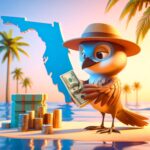Have you ever dreamed of spending winters basking in the warm sun while still having a place to call home in the summer? As a snowbird, this dream can become a reality! So, how do snowbirds afford two homes?

Snowbirds, also known as sunseekers or sun-chasers, are people who travel between residences in two different climates to avoid harsh winters.
Traditionally, snowbirds have been retirees, but with remote work opportunities, more young professionals are adopting the snowbird lifestyle as well!
Some snowbirds own two homes and travel between them depending on the season. Others own a primary home, and use a long term rental or portable housing such as an RV for their time away.
While having a second home is a significant financial commitment, with proper planning it can be achievable even on an average income.
In this guide, I’m going to tell you all the secrets about ways that snowbirds manage to afford two homes. So, whether it’s something you’re ready for now or what to plan for in the future, you can keep these helpful planning tips in mind.
How Much Does the Snowbird Lifestyle Cost?
The first step to affording two homes as a snowbird is understanding the true costs involved. Here are the main expenses you’ll need to account for:
- Housing Costs: This includes mortgage/rent, property taxes, insurance, utilities, HOA fees, maintenance, and furnishings for two residences. Housing is typically the biggest expense for snowbirds.
- Travel Costs: There’s the cost of gas and wear-and-tear on your vehicle driving between homes. Flying could be cheaper depending on distance. You may also have lodging costs during the transition, particularly when driving longer distances.
- Healthcare: You’ll need to arrange continuous coverage and access to providers in both locations. This can get complex with insurance networks.
- Taxes: You may face paying income tax in two states if residency requirements aren’t met for a primary home. Property taxes also double. Make sure to read more about Arizona Snowbird Tax Rules (or any of the other great snowbirding states)!
- Lost Income: If you take seasonal jobs, you lose income during transitions. If you’re retired, investment income drops if assets are tied up in a second home.
- Lifestyle Inflation: With a second home comes temptation to spend more on furnishings, entertainment, dining out, etc. Expenses tend to creep up.
Do a thorough analysis of your current expenses and projected costs for a second home to determine the yearly budget required to maintain two residences and fund travels between them. This will give you a target to aim for.
Financing Options for a Second Home
Once you know your target budget, here are some options to make owning two homes financially feasible:
Use Equity from Primary Home
Tapping into your home equity via a HELOC (Home Equity Line of Credit) or cash-out refinance allows you to use existing equity for a second property. This avoids having two mortgage payments.
Get a Vacation Home Loan
There are loan programs specifically for financing a second vacation home at competitive rates. Lenders understand dual property ownership.
Save Aggressively Beforehand
Save up a lump sum through disciplined budgeting before buying a second home. This provides a larger down payment and reduces reliance on financing.
Rent Out Properties
Generating rental income from your properties when not occupying them helps offset costs. Sites like Airbnb and VRBO facilitate short-term vacation rentals.
Invest Wisely for Retirement
If you diligently invest in retirement accounts like 401(k)s and IRAs over your working years, this provides funds to tap for second home ownership when the time comes.
Downsize Primary Residence
Moving from a large house to a smaller home or condo lowers your primary housing costs, freeing up your budget for a second property.
With strategic financing and saving methods, snowbirds make owning two homes work! The key is starting financial preparations early.
Choosing Locations for Snowbird Homes
Selecting the right locations for your two homes is critical for an enjoyable and affordable snowbird experience. Here are key factors to evaluate:

Climate
Compare average temperatures and weather patterns to identify locations with drastically different winter-summer climates. This maximizes the incentive to migrate throughout the year.
If you plan to own a second home, you’ll also want it in an area not highly prone to natural disasters. After all, you don’t want your home being destroyed when you’re halfway across the country, as that creates a mess to deal with!
Budget
Research housing costs, taxes, healthcare expenses, and general cost of living in potential locations. Less expensive areas stretch your budget further.
Travel Distance
Consider the time, costs, and burden of frequently traveling between two distant points. Closer cities allow for easier transitions.
For farther destinations, choose an area close to a major airport or train station so you can use other options to book travel more economically.
Tax Implications
Consult a tax professional to understand impacts of claiming residency in different states. Some states like Florida have tax advantages for snowbirds. Check out my guide on Florida Snowbird Tax Rules to learn more!
Proximity to Family
Maintaining one or both of your homes near family or close friends is always ideal. That way, they can check in on your property for you while you’re away.
If that’s not an option for you, it’s still fine! I still recommend making sure your snowbirding home is near an airport or other major transportation hub in case you ever need to get back to your primary residence for a family emergency.
Lifestyle Appeal
Ensure both locations offer amenities, attractions, and activities aligned with your lifestyle priorities, from urban culture to outdoor recreation.
Weigh all these factors carefully to identify two home bases meeting your needs and budget. Compromise may be required to strike the perfect balance.
Snowbird Housing Options
Beyond buying two traditional single-family homes, snowbirds have other creative housing arrangements to consider. These can help to significantly offset the costs of owning two homes and make it more affordable:
Own One Home, Rent the Other
To reduce housing costs and maintenance demands, consider owning your primary home while renting your winter retreat. Short-term vacation rentals are ideal for snowbirds.
Alternatively, you can own homes in both locations, but rent the one you’re not currently using out during the opposing seasons. While it’s some work to vet reliable tenants, the rent you bring in will help offset the cost of a second mortgage!
Co-own a second home with family or friends to split costs and responsibilities. Create a legal agreement defining each person’s rights.
House Swapping
Use home exchange services to swap houses with another owner in your desired winter destination rent-free. You watch their home while they watch yours.
Mobile Home/RV
A mobile home or RV can serve as an affordable second residence. Campgrounds and RV parks offer flexible leasing options. Storage fees apply when not in use.
Houseboats
Another unique approach is living on a houseboat part of the year! Dock slips provide access to waterfront communities.
Get creative in your housing search to uncover arrangements aligned with your budget and needs. You may be pleasantly surprised by what’s possible outside the norms of home ownership.
Optimizing Finances as a Snowbird
Beyond home purchasing strategies, optimizing your overall finances helps create breathing room in your budget to afford and enjoy the snowbird lifestyle. Here are some money management tips:

- Track expenses closely in a budget to identify waste and excessive spending. Eliminate unnecessary costs.
- Downgrade vehicles to more economic models with better gas mileage to reduce transportation costs.
- Learn DIY home maintenance skills to avoid hiring contractors for minor issues.
- Monitor investments continuously and shift assets to maximize returns.
- Use credit card points and airline miles to cover travel costs between homes.
- Take advantage of discounts for seniors, military, AAA members, etc. to save on expenses.
- Visit restaurants during happy hours, early bird specials, and Restaurant Week promotions when prices are lower.
- Shop sales especially out of season when snowbird destinations deeply discount summer clothing and supplies for visiting winter residents.
Through mindful spending and proactive money management, you can make the finances work to have the snowbird lifestyle you’ve always envisioned!
Making Snowbirding Work With Children
Contrary to popular belief, snowbirding isn’t just for empty nesters! With remote schooling options, having children doesn’t have to stop you from being a snowbird. Here’s how to balance kids and two homes:
Homeschool Year-Round
Homeschooling gives you location flexibility. Create a curriculum meeting state standards and educate your kids yourself as you travel.
Enroll in Online School
Virtual schools like Connections Academy offer tuition-free accredited online education. Kids can log in wherever you roam, so long as you’ve got an internet connection available.
Swap Traditional School for Tutoring
Hire tutors at your winter home for core subjects. Add electives like art, music, and sports for socialization.
Alternate Traditional and Remote School
Enroll your child in traditional school for fall and spring semesters attending in person when home. Do remote online school just for winter.
Send Kids to Boarding School
Consider sending your kids to a boarding school while you snowbird. They get consistency in one location.
With creativity and commitment, snowbirding can work for families! The travel and cultural experiences expose children to life-enriching adventures.
Finding Remote Work as a Snowbird
In addition to retirees, remote work empowers more young professionals to become snowbirds each year. Thanks to technology, you can now work from anywhere with an internet connection!

Here are some examples of remote jobs perfect for the snowbird lifestyle:
- Freelance Writer: Write articles, social media posts, web content, and more on a freelance basis for companies worldwide.
- Virtual Assistant: Provide administrative support like calendar management, email handling, and data entry remotely for clients.
- ESL Teacher: Teach English to students abroad via online video platforms without having to relocate overseas.
- Social Media Manager: Manage social media accounts, post engaging content, and run ads for brands remotely.
- Web Developer: Build, design, and program websites for businesses from the comfort of your (second) home.
- Customer Service Representative: Assist customers over phone, email, chat, and social media across time zones.
- Transcriptionist: Convert audio and video files to text documents working 100% online.
- Tutor: Help students improve academics through virtual tutoring over video chat.
With the rise of remote work, not being tied to an office gives snowbirds far greater freedom and flexibility to divide time between two beautiful locations!
Evaluating Your Snowbird Financial Readiness
How can you gauge whether your finances are truly ready to make the leap into snowbird second home ownership? Ask yourself these key questions:
- Do I have at least 20% saved for a downpayment on a second home?
- Can I pay my current bills for 6 months without income if needed?
- Am I on track to fully fund retirement based on my age?
- Can I afford maintenance costs and major repairs on two homes?
- Will I have reliable healthcare coverage in both locations?
- Can I afford to travel between homes multiple times per year?
- Will owning two homes prevent me from also traveling and enjoying retirement?
If you answered yes to most of these questions, you are likely in a healthy financial position to become a snowbird with two homes! Just be sure to run the numbers thoroughly and consult financial and tax professionals before taking the plunge.
FAQs: Owning Two Homes as a Snowbird
Still have questions about transitioning to the snowbird lifestyle? Here are answers to some frequently asked questions:
Where do most snowbirds buy second homes?
The most popular snowbird destination is Florida by far, followed by Arizona and California.
Texas, North Carolina, South Carolina, Alabama, and Georgia are emerging hotspots too.
How much time do snowbirds spend in each home?
Most snowbirds spend around 3-5 months in their winter home enjoying the warm weather and 7-9 months in their primary summer residence closer to family.
However, this can vary based on personal preference, prior commitments, and the weather in your specific locations.
What is the best way to find a snowbird winter home rental?
Use a vacation rental site that specializes in furnished rentals for snowbirds. There are even communities designed specifically for the lifestyle.
Avoid short-term rentals, as the fees can be very high, and instead focus on long term options to help reduce costs. You can also look at home swapping options if you’d like.
Should I buy or rent an RV for snowbirding?
Renting an RV provides more flexibility if you aren’t used to driving an RV and are still getting used to the various campgrounds and amenities.
Once you know the features you like and don’t like, as well as what your favorite campgrounds have and don’t have, you’ll be able to make a better decision on purchasing an RV that fits your needs.
What are the biggest challenges of being a snowbird?
Frequent traveling, home maintenance coordination, and lack of community roots are commonly cited challenges.
Proper planning and preparation helps overcome these.
More Helpful Guides on Becoming a Snowbird
- What is Snowbird Season?
- How to be a Snowbird on a Budget
- Top Tips for Snowbirds
- Snowbird Relocation Guide
- Snowbird Social Groups & Associations
Find Your Dream Snowbird Lifestyle
As you can see, with thorough financial planning and smart housing strategies, the snowbird lifestyle of owning homes in two beautiful locations is achievable for regular folks – not just the wealthy elite!
If you’re willing to budget diligently, make some tradeoffs, and optimize your income streams through retirement investing and remote work, you can split your time between a cozy summer home and sunny winter retreat.
Stop dreaming and start preparing now to live the snowbird life you’ve always imagined! Consult the financial professionals and tax experts to create your personalized snowbird game plan.
Before you know it, you’ll be lounging poolside while snow piles up back home – all without breaking the bank. Take the first step today towards an adventurous, climate-hopping snowbird retirement or career!
- Best Seafood Restaurants in Myrtle Beach South Carolina - July 17, 2024
- 20+ Fun Things to Do in Tempe Arizona: A Complete Guide - July 5, 2024
- Discover the Best Restaurants in Beaufort South Carolina - June 19, 2024




